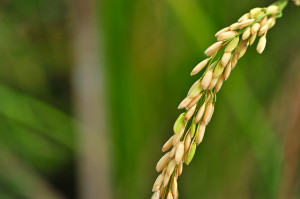By Steve Prager (CIAT)
Rice is an important food around the world and, in the case of Latin America and the Caribbean (LAC), makes up approximately 11.5% of the diet (CGIAR, 2014). In LAC, rice serves an important role in food security and is, likewise, an important commodity in both domestic and international economic activity. Yet, production of rice in Latin America only accounts for approximately 3.7% (CGIAR, 2014; FAO, 2015) of the global total.
What does this mean for rice producers and consumers in Latin America? In short, given relatively low levels of production and high levels of dependence on imported product, the sustainability of rice production in LAC is highly sensitive to the global market. Likewise, this adds a certain level of volatility and serves to link food security in Latin America and the Carribean to any number of factors outside the region.
What can we do? Given relatively favorable growing conditions and adequate availability of water in many places, LAC has the potential to increase rice production. Ideally, increases of rice production should be done in a manner that also bolsters the agricultural sustainability of the crop. Research should address not only how to increase yields, but also how different investment decisions affect issues such as distributional equity, how to best use inputs, and more.
Where do we begin? The Global Futures and Strategic Foresight Program seeks to offer “foresight” into complex problems such as these. In order to identify potential research focus areas of the program, CIAT recently conducted a two-part prioritization exercise for rice.
The first phase involved asking 112 researchers around the world, concentrating in Latin America, to prioritize fundamental research activities. In the second phase, CIAT asked members of the Latin American Foundation for Irrigated Rice (FLAR), a voluntary consortium of more than 30 public and private sector organizations in 17 countries that is dedicated to developing new technology for sustainable rice production, to evaluate those priorities relative to the following criteria:
- Diminishing poverty*,
- Increasing food security*,
- Improving nutritional quality and health*,
- Preservation of the environment and efficient use of natural resources and water*,
- Improving social equality and gender balance in decision-making,
- Strengthening the rice sector and its institutions.
(* Criteria directly aligned with CGIAR System Level Outcomes )
The results offer a jump-off point for researchers with interest in irrigated rice and in improving the sustainability of rice agricultural in Latin America. For full results and to contrast the perspectives of the two groups of stakeholders, please see the full report and poster (both in Spanish):
- Informe: Prioridades de investigación (Research priority report)
- Poster: Portafolio de opciones de investigacion
Please see full blog post and result summary in English on CIAT’s Decision and Policy Analysis Research Area (DAPA) website here: http://dapa.ciat.cgiar.org/practical-sustainability-reconciling-researcher-and-stakeholder-perspectives-in-rice/






